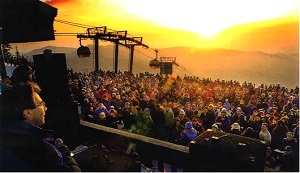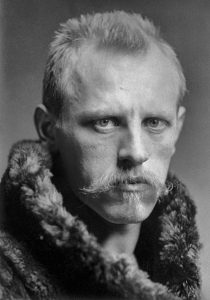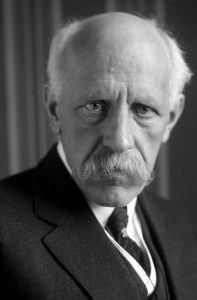It’s 4:30 in the morning as I load my skis and get in the gondola. I join a group of non-skiers already in the car. I ask them where they’re from and they tell me they’re from Fairfax, Vermont. That means they had to get up at 2:30AM to get ready and make the more-than-an-hour drive to the mountain. We ride up to the Cliff House in the dark – an interesting experience in itself. Along the way you can hear voices from below of people hiking or skinning up. Looking back toward the village of Stowe you can see a growing line of headlights coming up the Mountain Road. We get out of the gondola in the bright lights of the top building where the coffee, donuts, and other pastries are already available for consumption. Someone says “Happy Easter!” and yes, it’s the annual Easter Sunrise Service atop Mount Mansfield.

Easter 2013 – Rev. Bruce Comiskey
This is the second year in a row that there won’t be a Sunrise Service on the mountain due to COVID. The tradition began in 1955, more than 65 years ago. I hope that next year the tradition can return.
The annual Sunrise Service brings together an interesting mix of people from those primarily there for the free skiing to those who are actually there for the Easter service. For some it is an annual social celebration that includes the service and skiing followed by brunch. The attendance varies with the weather from a few hundred to well over a thousand.
It is a special experience when you are lucky enough to have a clear Easter dawn that bathes the whole top of the mountain in a pink and purple glow. Then the sun starts to break over the eastern horizon – first as just a bright beam of light and then eventually the entire sun appears. Whether you came for the skiing or to celebrate Easter, whether you consider yourself religious or not, the experience can best be described as spiritual.
Which brings us to the quote I shared in last week’s trivia question: “It is better to go skiing and think of God, than go to church and think of skiing.” I saw the quote on a poster at the beginning of the ski season. My first reaction was how have I not seen this before? Or why don’t I already own this? My second reaction was to wonder who the author was.

By Deutsches Bundesarchiv, CC BY-SA 3.0, https://en.wikipedia.org/w/index.php?curid=28409775
The quote is attributed to Fridtjof Nansen of Norway who was born in 1861. To be accurate, his actual quote was “It is better to go skiing and think of God, than go to church and think of sport.” But I think the slight modification from “sport” to “skiing” makes it more appropriate for me.
Nansen began skiing at age 2 which of course was primarily cross country although I’m sure they skied down hills when they encountered them. At age 10 he tried ski jumping despite his parents’ disapproval. In addition to skiing he became an accomplished skater as well. At 18 he set a world record for the one mile skate. At age 19 he won the first of his 11 national cross country ski championships.
However to say Nansen was just a skier would be like saying Einstein was just a PhD! Nansen was a polar explorer, a zoologist, an oceanographer, a politician/diplomat, and a human rights advocate.
As a polar explorer he led the first expedition to successfully traverse Greenland on skis in 1888. Although not as famous as Amundsen and Peary in their quest for the North Pole, Nansen did lead an expedition that reached a record northern latitude at the time. In the process of these adventures he designed improved sleeping bags, clothing, and stoves for use in cold weather.

By Deutsches Bundesarchiv, CC BY-SA 3.0, https://en.wikipedia.org/w/index.php?curid=28409775
In 1905 Nansen was an outspoken advocate to dissolve the Norway-Sweden Union and have an independent Norway. He became the movement’s spokesman to the English-speaking world garnering their support for a free Norway. He also negotiated with Denmark to have their Prince Charles assume the role of king in the new Norwegian monarchy.
After World War I Nansen went to work for the League of Nations to address the refugee problem that resulted from the war. His work in this area led to him receiving the Nobel Peace Prize in 1922.

Leave a Reply